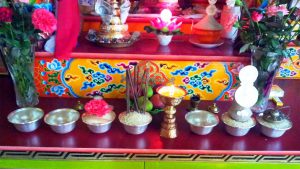The Bhavachakra, the wheel of life is a mandala representing the Buddhist view of the universe. To Buddhist, existence refers to a cycle of life, death, rebirth and suffering that they seek to escape altogether.
Bhava means “being, worldly existence, becoming, birth, production”. Chakra means, “wheel, cycle or circle”.The creature holding the Wheel of Life in his hooves is Yama, the wrathful dharmapala who is Lord of the Hell Realm.
The terrible face of Yama represents impermanence, peers over the top of the Wheel. In spite of his appearance, Yama is not evil. He is a wrathful dharmapala, a creature devoted to protecting Buddhism and Buddhists. Although we may be frightened of death, it is not evil; just inevitable.
In legend, Yama was a holy man who believed he would realize enlightenment if he meditated in a cave for 50 years. In the 11th month of the 49th year, robbers entered the cave with a stolen bull and cut off the bull’s head. When they realized the holy man had seen them, the robbers cut off his head too.
Then the holy man put on the bull’s head and assumed the terrible form of Yama. He killed the robbers, drank their blood, and threatened all of Tibet. He could not be stopped until Manjushri, Bodhisattva of Wisdom, manifested as the even more terrible dharmapala Yamantaka and defeated Yama. Yama then became a protector of Buddhism.
The bhavacakra consists of the following elements:
- The pig, rooster and snake in the hub of the wheel represent the three poisonsof ignorance, attachment and aversion.
- The second layer represents karma.
- The third layer represents the six realms of samsara.
- The fourth layer represents the twelve links of dependent origination.
- The fierce figure holding the wheel represents impermanence.
- The moon above the wheel represents liberationfrom samsara or cyclic existence.
- The Buddhapointing to the white circle indicates that liberation is possible.
Symbolically, the three inner circles, moving from the center outward, show that the three poisons of ignorance, attachment, and aversion give rise to positive and negative actions; these actions and their results are called KARMA. Karma in turn gives rise to the six realms, which represent the different types of suffering within samsara.
The fourth and outer layer of the wheel symbolizes the twelve links of dependent origination; these links indicate how the sources of suffering—the three poisons and karma—produce lives within cyclic existence.
The fierce being holding the wheel represents impermanence; this symbolizes that the entire process of samsara or cyclic existence is impermanent. The moon above the wheel indicates liberation. The Buddha is pointing to the moon, indicating that liberation from samsara is possible.
Hub: the three poisons
In the hub of the wheel are three animals: a pig, a snake, and a bird. They represent the three poisons of ignorance, aversion, and attachment, respectively.
The pig stands for ignorance; this comparison is based on the Indian concept of a pig being the most foolish of animals, since it sleeps in the dirtiest places and eats whatever comes to its mouth.
The snake represents aversion or anger; this is because it will be aroused and strike at the slightest touch.
The bird represents attachment (also translated as desire or clinging). The particular bird used in this diagram represents an Indian bird that is very attached to its partner.
These three animals represent the three poisons, which are the core of the bhavacakra. From these three poisons, the whole cycle of existence evolves.
In many drawings of the wheel, the snake and bird are shown as coming out of the mouth of the pig, indicating that aversion and attachment arise from ignorance. The snake and bird are also shown grasping the tail of the pig, indicating that they in turn promote greater ignorance.
Under the influence of the three poisons, beings create karma, as shown in the next layer of the circle.
Second layer: karma
The second layer of the wheel shows two-half circles:
- One half-circle (usually light) shows contented people moving upwards to higher states, possibly to the higher realms.
- The other half-circle (usually dark) shows people in a miserable state being led downwards to lower states, possibly to the lower realms.
These images represent karma, the law of cause and effect. The light half-circle indicates people experiencing the results of positive actions. The dark half-circle indicates people experiencing the results of negative actions. Propelled by their karma, beings take rebirth in the six realms of samsara, as shown in the next layer of the circle.
Third layer: the six realms of samsara
The third layer of the wheel is divided into six sections that represent the six realms of samsara, or cyclic existence, the process of cycling through one rebirth after another. These six realms are divided into three higher realms and three lower realms. The wheel can also be represented as having five realms, combining the God realm and the Demi-god realm into a single realm.
The three higher realms are shown in the top half of the circle:
- God realm (Deva):the gods lead long and enjoyable lives full of pleasure and abundance, but they spend their lives pursuing meaningless distractions and never think to practice the dharma. When death comes to them, they are completely unprepared; without realizing it, they have completely exhausted their good karma (which was the cause for being reborn in the god realm) and they suffer through being reborn in the lower realms.
- Demi-god realm (Asura):the demi-gods have pleasure and abundance almost as much as the gods, but they spend their time fighting among themselves or making war on the gods. When they make war on the gods, they always lose, since the gods are much more powerful. The demi-gods suffer from constant fighting and jealousy, and from being killed and wounded in their wars with each other and with the gods.
- Human realm (Manuṣya):humans suffer from hunger, thirst, heat, cold, separation from friends, being attacked by enemies, not getting what they want, and getting what they don’t want. They also suffer from the general sufferings of birth, old age, sickness and death. Yet the human realm is considered to be the most suitable realm for practicing the dharma, because humans are not completely distracted by pleasure (like the gods or demi-gods) or by pain and suffering (like the beings in the lower realms).
The three lower realms are shown in the bottom half of the circle:
- Animal realm (Tiryagyoni):wild animals suffer from being attacked and eaten by other animals; they generally lead lives of constant fear. Domestic animals suffer from being exploited by humans; for example, they are slaughtered for food, overworked, and so on.
- Hungry ghost realm (Preta):hungry ghosts suffer from extreme hunger and thirst. They wander constantly in search of food and drink, only to be miserably frustrated any time they come close to actually getting what they want. For example, they see a stream of pure, clear water in the distance, but by the time they get there the stream has dried up. Hungry ghosts have huge bellies and long, thin necks. On the rare occasions that they do manage to find something to eat or drink, the food or water burns their neck as it goes down to their belly, causing them intense agony.
- Hell realm (Naraka):hell beings endure unimaginable suffering for eons of time. There are actually eighteen different types of hells, each inflicting a different kind of torment. In the hot hells, beings suffer from unbearable heat and continual torments of various kinds. In the cold hells, beings suffer from unbearable cold and other torments.
Among the six realms, the human realm is considered to offer the best opportunity to practice the dharma. In some representations of the wheel, there is a buddha or bodhisattva depicted within each realm, trying to help sentient beings find their way to nirvana.
Outer rim: the twelve links
The outer rim of the wheel is divided into twelve sections that represent the Twelve Nidānas. As previously stated, the three inner layers of the wheel show that the three poisons lead to karma, which leads to the suffering of the six realms. The twelve links of the outer rim show how this happens—by presenting the process of cause and effect in detail.
These twelve links can be understood to operate on an outer or inner level.
- On the outer level, the twelve links can be seen to operate over several lifetimes; in this case, these links show how our past lives influence our current lifetime, and how our actions in this lifetime influence our future lifetimes.
- On the inner level, the twelve links can be understood to operate in every moment of existence in an interdependent manner. On this level, the twelve links can be applied to show the effects of one particular action.
By contemplating on the twelve links, one gains greater insight into the workings of karma; this insight enables us to begin to unravel our habitual way of thinking and reacting.
The twelve causal links, paired with their corresponding symbols, are:
- Avidyālack of knowledge – a blind person, often walking, or a person peering out
- Saṃskāraconstructive volitional activity – a potter shaping a vessel or vessels
- Vijñānaconsciousness – a man or a monkey grasping a fruit
- Nāmarūpaname and form (constituent elements of mental and physical existence) – two men afloat in a boat
- Ṣaḍāyatanasix senses (eye, ear, nose, tongue, body, and mind) – a dwelling with six windows
- Sparśacontact – lovers consorting, kissing, or entwined
- Vedanāpain – an arrow to the eye
- Tṛṣṇathirst – a drinker receiving drink
- Upādānagrasping – a man or a monkey picking fruit
- Bhavacoming to be – a couple engaged in intercourse, a standing, leaping, or reflective person
- Jātibeing born – woman giving birth
- Jarāmaraṇaold age and death – corpse being carried
The figure holding the wheel: impermanence
The wheel is being held by a fearsome figure which represents impermanence. This figure is often interpreted as being Mara, the demon who tried to tempt the Buddha, or as Yama, the lord of death. Regardless of the figure depicted, the inner meaning remains the same–that the entire process of cyclic existence (samsara) is transient; everything within this wheel is constantly changing.
Yama has the following attributes:
- He wears a crown of five skulls that symbolize the impermanence of the five aggregates. (The skulls are also said to symbolize the five poisons).
- He has a third eye that symbolizes the wisdom of understanding impermanence.
- He is sometimes shown adorned with a tiger skin, which symbolizes fearfulness. (The tiger skin is typically seen hanging beneath the wheel.)
- His four limbs (that are clutching the wheel) symbolize the sufferings of birth, old age, sickness, and death.
The moon: liberation
Above the wheel is an image of the moon; the moon represents liberation from the sufferings of samsara. Some drawings may show an image of a “pure land” to indicate liberation, rather than a moon.
The Buddha pointing to the white circle: the path to liberation
The upper part of the drawing also shows an image of the Buddha pointing toward the moon; this represents the path to liberation. While in Theravada Buddhism this is the Noble Eightfold Path, in Mahayana Buddhism this is the Bodhisattva path, striving to liberation for all sentient beings. In Tibetan Buddhism, this is Lamrim, which details all the stages on the path, while Zen has its own complicated history of the entanglement of meditation practice and direct insight.




